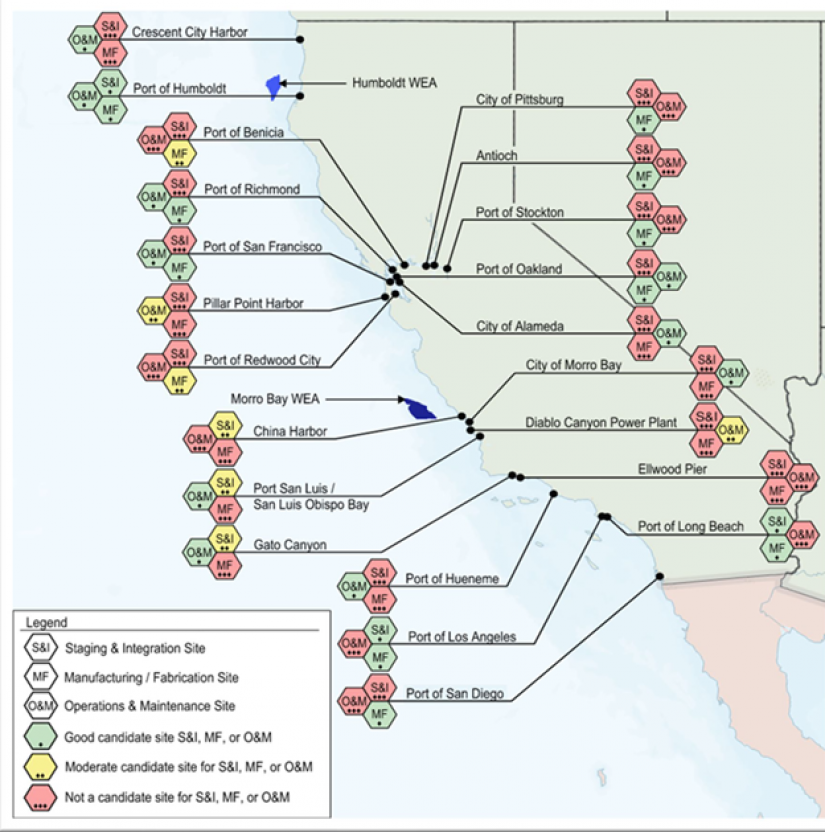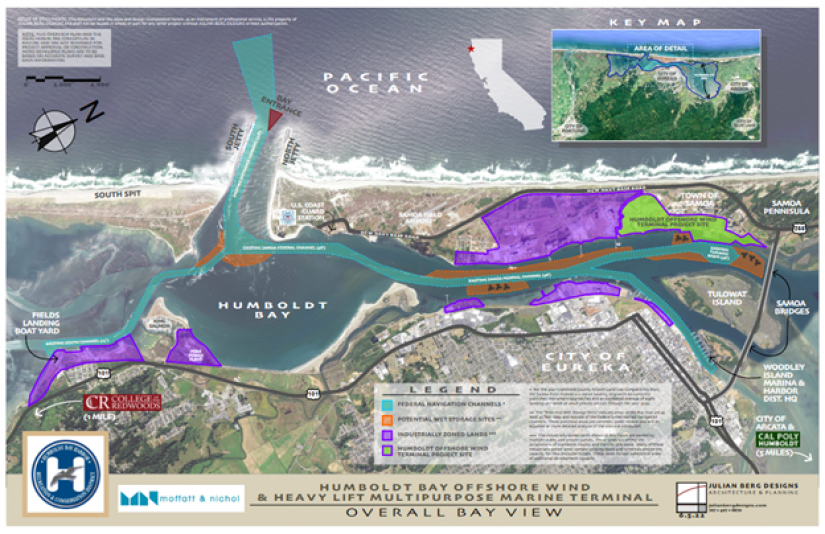Breadcrumb
- California Offshore Winds
- Port Infrastructure Assessment
Port Infrastructure Assessment
- What is the extent of Central Coast’s current port infrastructure?
Main harbors in San Luis Obispo County include Port San Luis and Morro Bay, which are used to support a small amount of commercial fishing and primarily serve recreational boaters. The Morro Bay harbor provides docking, mooring, and processing facilities. [1] There is also an intake cove area used for operational activities at the Diablo Canyon Power Plant. In Santa Barbara County the main harbor is Santa Barbara Harbor. [3]
- What port infrastructure is required to support California floating offshore wind projects?
According to the National Renewable Energy Lab (NREL), to meet the state’s offshore wind target of 25 gigawatts by 2045, four staging and integration sites and at least eight operations and maintenance sites, as well as the investment of about $5 billion, would likely be required for efficient deployment of floating offshore wind projects. More ambitious offshore wind scenarios will require an increased number of both types of sites and additional investments. [2] The State of California’s Port Readiness Plan prepared for the California State Lands Commission suggests that $11-12 billion may be required to upgrade existing port infrastructure to cover ports for staging and integration sites (Humboldt, Long Beach), for turbine and turbine foundation manufacturing (San Francisco, Long Beach, San Diego, Bay Area, Humboldt, Los Angeles), for mooring lines and anchor storage (Humboldt, Bay Area) and operation and maintenance (potentially multiple ports near wind areas). [4]
Expanding the West Coast’s port network to create a supply chain to support the state and regional economy would require the development of at least sixteen manufacturing fabrication sites. It is unlikely that any individual state on the West Coast would have sufficient manufacturing capacity to fabricate all of the components needed for a supply chain to meet offshore wind targets. There is a need for a coordinated approach to building a comprehensive port network that facilitates strategic planning and collaboration between California, Oregon, and Washington to create resilient, cost-effective, equitable, and impactful infrastructure on the West Coast.
- What are the challenges for using and updating existing port infrastructure?
Existing port infrastructure is inadequate for offshore wind projects. If new infrastructure will be built to address deficiencies in existing port infrastructure, there are many challenges including the uncertainty and time required for permitting, the need for a significant construction workforce, and conflict resolution between groups with different priorities. [2]
- Will new or updated infrastructure in California be necessary to support floating offshore wind projects?
There are several sites in California that have been identified by NREL as suitable for serving as staging and integrating sites and manufacturing fabrication sites including the Port of Los Angeles, the Port of Humboldt, and the Port of Long Beach– the latter two of which have announced the intent to develop a floating wind installation site. There is a concentration of sites in the San Francisco Bay Area that could be suitable for manufacturing fabrication sites (e.g. Ports of Richmond, San Francisco, Oakland, Stockton, Antioch, Pittsburg) [2]. Manufacturing sites are anticipated to maximize economic benefits for California. [4]
The Port of Humboldt hopes to become a site for offshore wind developer to pursue manufacturing and fabrication, staging and integration, and operation and maintenance. Manufacturing and fabrication might include the production of blades, towers, nacelles (wind turbine), mooring lines, anchors, transmission cables, or floating foundations. This would require factories, transit sheds, and/or warehouse buildings. Staging and integration would require wharfs and yard facilities including a heavy-lift wharf and new berths.
- Who will pay for updating port infrastructure?
The California State Lands Commission report on port readiness suggests that offshore wind port development projects will not be commercially viable and that the State perhaps with money from the federal government and some private partners will need to have a plan to subsidize port site development. [4]
Since 2020 the Port of Humboldt has received nearly $446 million in grant funding to support offshore wind port infrastructure, including local funding, $11 million in State funding (State Lands Commission and California Energy Commission), and over $433 million in Federal Department of Transportation funding.
- How will California Communities be impacted by a potential expansion of port infrastructure?
Port infrastructure changes may impact other users of existing port facilities including commercial fishing companies, recreational fishing companies, and recreational boaters. Port development is, however, one of the first places where the offshore wind industry will generate potentially locally-based jobs.[4]
Community vulnerability and workforce accessibility indicators were used by NREL to evaluate energy justice impacts on port communities. According to the AB 525 Port Readiness Study, developing the Port of Humboldt for Staging and Integration, along with the Ports of Los Angeles and Long Beach, would have the least impact across several factors as part of their environmental ranking assessment. According to the report, the greatest impacts would likely be to terrestrial biology, cultural resources, and demographic index, and with the least impact on viewshed sensitivity, marine aquatic biology, State and Federal protected areas, existing infrastructure development, and land use compatibility. However, in comments to the AB 525 OSW Strategic Plan, concerns have been raised about the impact of port infrastructure to water quality, aesthetics, cultural landscapes, biological resources, recreation and other factors which a number of Tribes and communities depend upon. The Humboldt Bay area will require dredging if it will be used as a Staging and Integration site. Concerns have been raised about the dredging because of potential toxic substances that may be in the soil from former industries in the region.
The Central California community vulnerability is low–except for Port San Luis, which is considered to have moderate community vulnerability, due to higher particulate matter (PM) 2.5 exposure, adult asthma rates, and percent at or below 200% poverty line. Community vulnerability could vary significantly if a port is added to the Central Coast. In terms of workforce accessibility, Morro Bay, Diablo Canyon, and Port San Luis are not considered disadvantaged. Ellwood Pier is considered moderately workforce disadvantaged because of linguistic isolation and unemployment factors. [2]
- What are the three major types of ports needed in support of floating offshore wind development?
Three types of ports are needed for offshore wind development. First, manufacturing and fabrication ports will be needed for building, storing, and assemblying blades, towers, nacelles, foundations subcomponents, and foundation assembly. Possible proposed sites include Port of Humboldt, Port of San Francisco (and other bay area ports), Port of Los Angeles, Port of Long Beach, and Port of San Diego.
The space needed for building these parts is provided below.
Wind Farm Infrastructure Number of ports needed Acreage Needed for Each Manufacturing and Fabrication Blade 2 100 acres Nacelle (Wind Turbine Hub) Assembly 1 25 acres Foundation Subcomponents 4 40 acres Foundation Assembly 4 40 acres A second type of port is a staging and integration port where components are delivered, stored, and assembled into complete floating wind turbine systems ready to be towed out for deployment. The State will require three to five 80 acre ports. Likely ports for staging and integration are Port of Humboldt, Los Angeles, and Long Beach. The Port of Humboldt announced a project to provide 180 plus acre sites for staging and integration as well as manufacturing and fabrication. The Port of Long Beach has announced a project to provide 400 acres for staging and integration plus manufacturing and fabrication.
A final type of port is an Operation and Maintenance Port. The state if anticipated to need between 9 to 16 berths to support Operation and Maintenance vessels.

- What is the Extent of Humboldt Bay Port Infrastructure?

- References
[1] Harbors. (n.d.). San Luis Obispo Council of Governments. https://slocog.org/programs/public-transportation/harbors
[2] Shields, M., Cooperman, A., Krieder, M., Oteri, F., Hemez, Z., Gill, L., Sharma, A., Fan, K., Musial, W., Trowbridge, M., Knipe, A., & Lim, J. (2023). The Impacts of Developing a Port Network for Floating Offshore Wind Energy on the West Coast of the United States (NREL/TP-5000-86864). National Renewable Energy Laboratory. https://www.nrel.gov/docs/fy23osti/86864.pdf
[3] Porter, A., Gostic, M. (2022). Central Coast Emerging Industries Waterfront Siting and Infrastructure Study. In REACH. https://reachcentralcoast.org/wp-content/uploads/Waterfront-Infrastructure-Report-121522.pdf
[4] California State Lands Commission, AB 525 Port Readiness Plan, Final Report (July 7, 2023), https://slcprdwordpressstorage.blob.core.windows.net/wordpressdata/2023/07/AB525-Port-Readiness-Plan_acc.pdf